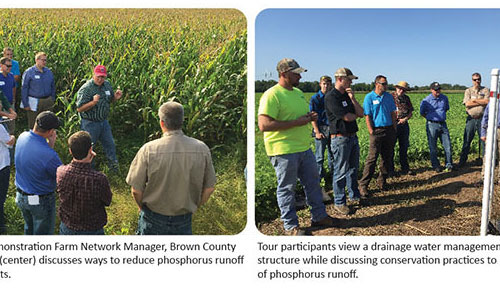

Congressman Reid Ribble visited Northeast Wisconsin Tuesday looking at ways to make local waterways cleaner with the USDA Natural Resources Conservation Service (NRCS), the Great Lakes Demonstration Farm Network, local farmers, and the Brown County Conservation Department who organized and lead the tour.
"We're starting to look at what's happening in Green Bay, Lake Winnebago, the Fox River, and you can even translate this to Lake Erie with large algae blooms that are destroying the economy in those areas," said Representative Reid Ribble, Congressman for Wisconsin's 8th district.
Many factors affect water quality, one of which can be phosphorus runoff. The NRCS in Wisconsin is helping farmers incorporate conservation activities that will reduce the amount of phosphorus from reaching the Great Lakes. In the past three years, NRCS has provided over $9 million dollars in financial assistance to help farmers in the Lower Fox Watershed to install conservation practices which reduce and control the runoff. The Lower Fox Watershed encompasses portions of Brown, Outagamie, Calumet, Winnebago, and Manitowoc County.
"Reducing phosphorus is the key to cleaner water" said Jimmy Bramblett, NRCS State Conservationist in Wisconsin. "Reducing the amount of phosphorus entering these lakes will improve water quality, aquatic and wildlife habitat, and recreation."
The landscape of the Fox River area presents unique challenges for farmers to control runoff but some are working with NRCS to help make a change. Representative Ribble and others toured farms to take a look at what farmers are doing to adopt conservation practices on their farms.
"We're keeping a lot of the moisture and rainfall on our land rather than it running off of our agricultural (due to conservation practices like cover crops)," Brent Petersen, Great Lakes Demonstration Farm Network Manager, said. Farmers said they are getting better yields and it is cost-effective. "Farmers are rapidly moving to try cover crops to start re-building the health of their soil and sustainability of their farmland, while also reducing phosphorus," said Bramblett. Cover crops reduce wind or water erosion by literally covering the soil. They also use up excess nutrients in the soil reducing risk of runoff, they sequester carbon, and improve soil structure.
"I just love it, what I'm seeing now," said farmer George Van Wychen. The Van Wychen's have been farming since 1977 and planting cover crops for 15 years. Their farm is part of the Phosphorus Reduction Initiative and serves as one of four demonstration farms in Northeast Wisconsin. Read more about the Van Wychen's successful implementation of conservation practices to help phosphorus runoff.
"We want to help get the word out to others farmers, there are new and better ways to farm that protect our water and environment. NRCS will work directly with you to offer assistance with this," said Bramblett. "When one farmer sees another farmer implementing a practice they're more willing to try to take on the risks associated with implementation of those measures."
Representative Ribble said improving water quality is important, but it is going to take some time and effort. "Whether it's 10 years from now, 15 or 20 years from now, where we don't have any hypoxic zones where the fish are dying in Green Bay, and most importantly that water clarity and water quality throughout the entire watershed gets better," Representative Ribble said.
For more information or to get started in reducing phosphorus runoff in your area, visit www.wi.nrcs.usda.gov , or contact the NRCS office at the USDA Service Center serving your county.
10.12.2015